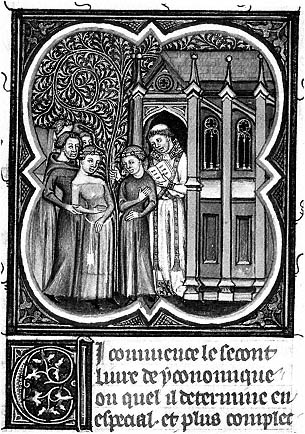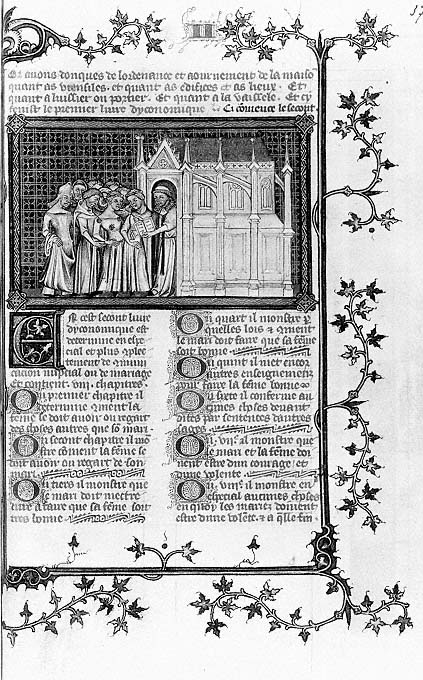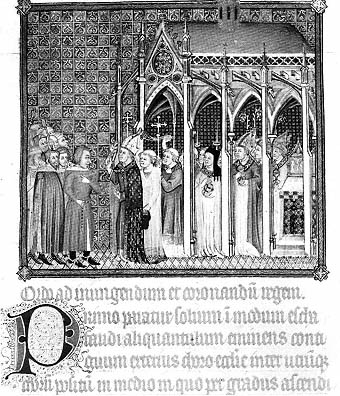Formal and Decorative Relationships
The illustrations for Book II of the Yconomique (Figs. 83 and 84) conclude the cycles of B and D . Compared to the miniatures of Book I of this text (Figs. 80 and 81), the program appears quite summary and routine. Even though the modern reader may find that the text of the Yconomique offers fascinating insights into both Aristotle's and Oresme's views on the institution of marriage, Oresme himself may have thought that the contents of Book II did not address the vital political interests of his primary readers. If Oresme felt this way, it could explain why the depiction of a wedding ceremony in Figures 83 and 84 provides such an extremely reductive version of the ideas expressed in the text. Indeed, the paradigmatic mode is that of neither a general model nor an example but that of a symbolic abbreviation. In this respect, the illustrations of Book II of the Yconomique recall those of Books II and, to a lesser extent, those of Book VIII of the Politiques (Figs. 55–57, 77, and 78). The common feature is a disjunction between complex textual development and radically simplified visual translations.
Figures 83 and 84 were again executed by the workshop of the Master of the Coronation Book of Charles V. Unlike Figure 80 in Book I, however, the hand of the master is not visible in these illustrations. Their composition depends on the scene of Charles V entering Reims cathedral from his Coronation Book (Fig. 85).[1] The most striking similarity is the representation of the church. Although far more simplified in Figure 83, the depiction in Figure 84 of the three bays and flying buttresses is quite close to those in the model. The motif of the priest standing at the main portal of the church derives from the reception of the king by the archbishop of Reims. It appears that a drawing in a model book was available for the use of members of the atelier, as is true of the miniatures of Book I.[2] It is obvious that Figure 83 is far smaller than Figure 84. This miniature is restricted to the width of the second column of the text, at the top of which it stands. Figure 83 is the first illustration in the Politiques and Yconomique program of B to share the column format and small dimensions after the prefatory miniatures of Oresme writing his translation (Fig. 44) and the dedication portrait (Fig. 45). These latter two examples precede the text proper of the Politiques . It is, therefore, correct to assume that Figure 83 occupies the lowest place in the hierarchy of importance among the text illustrations of this manuscript.
Figure 83
A Marriage Ceremony. Le yconomique d'Aristote, MS B.
The decorative structure of the folio of which Figure 83 is a part also reflects the lesser importance of the illustration. The ivy-leaf motif is confined to the miniature: the foliate borders in the margins of other illustrations from this manuscript are lacking. Also missing are rubrics to announce the introductory paragraph above which Figure 83 stands. The four-line foliate initial C of the opening word of this paragraph is also smaller than usual.
Figure 84, however, achieves greater prominence. As previous analysis has shown, the reformatting of D called for a regularity in the shapes of the illustrations. Thus, Figure 84 is a rectangle that occupies the width of the entire text block and achieves frontispiece status. This image—like the preceding illustration for Book I of the Yconomique —is somewhat smaller than the miniatures of the Politiques in the same manuscript. The decorative character of folio 375, where Figure 84 stands, is far more elaborate than that of Figure 83. Furthermore, the painted frame of Figure 84 establishes the miniature as a separate design element. In short, the revised format of D cedes to Figure 84 an importance that was lacking in Figure 83.
Figure 84
A Marriage Ceremony. Le yconomique d'Aristote, MS D.
Figure 85
The Reception of Charles V at the West Portal of Reims Cathedral.
Coronation Book of Charles V.
Figures 83 and 84 retain the distinctive uses of color noted in the previous miniatures of the two manuscripts. The bride in the center, who wears a rose robe, is flanked by a male figure (possibly her father) and the groom, both of whom wear light blue mantles. A partially seen figure on the left repeats the rose of the bride's dress, which contrasts with a red hood. The priest in the center stands out in his white robes and gold stole from these brightly colored figures on the left and the monochrome gray tones of the church on the right. In Figure 84, the color of the roof and body of the church echo those of Figure 83. A larger company than the five people in Figure 83, the group in Figure 84 is delineated in grisaille with rose washes. In both cases the application of gold picks out the decorations of the bride's dress and the jeweled circlets in the couples' hair. The spiraling foliate motif of the blue-and-gold background of Figure 83 presents a more active, if more limited, contrast to the figures than the more extensive rust-and-gold geometric background of Figure 84.


